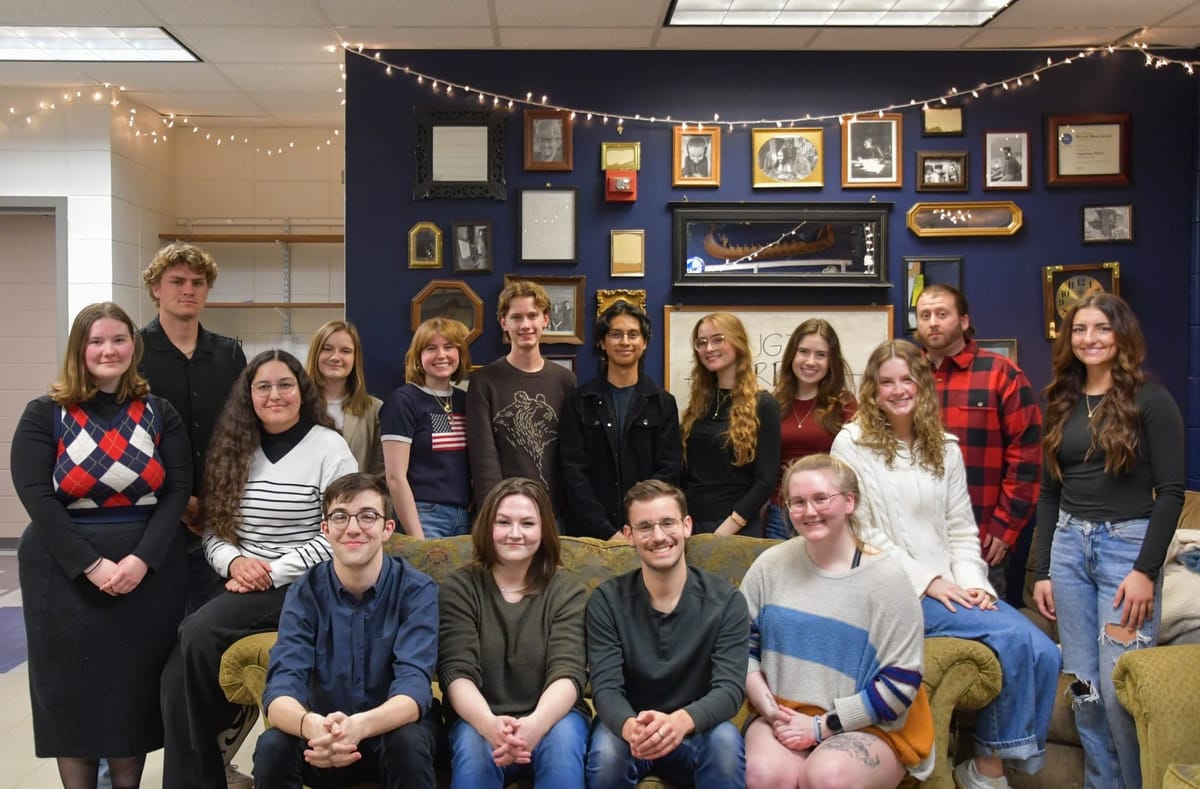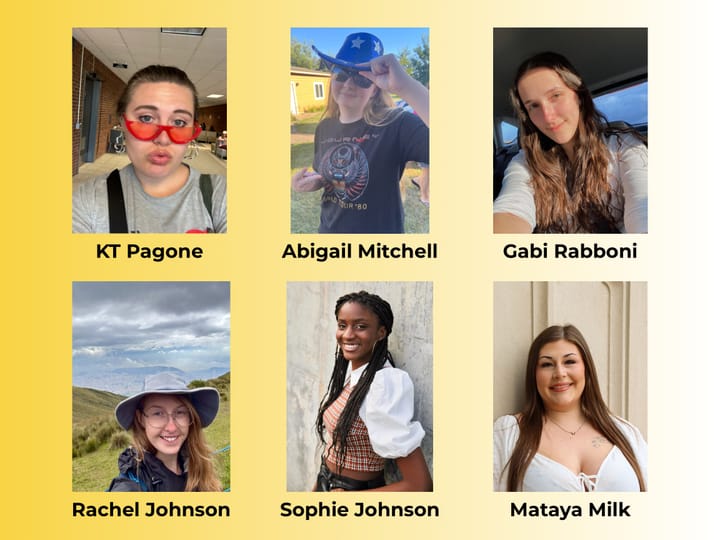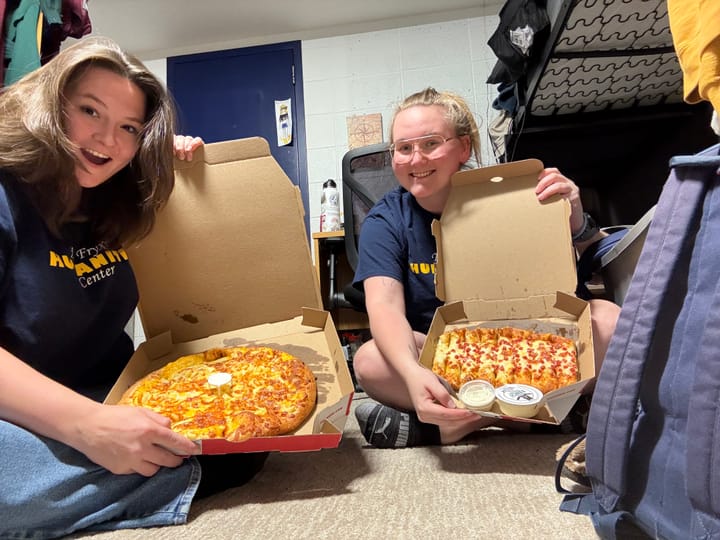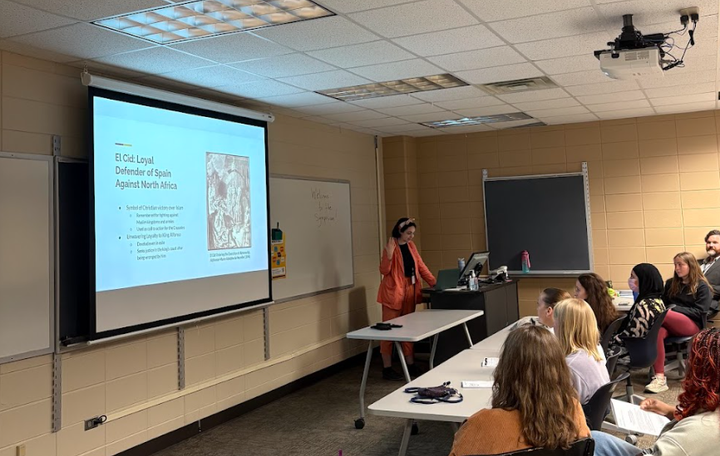Take a look into the Augustana Mirror

It’s Friday afternoon, and the sun is shining through the window. You’re studying, grabbing a coffee with a friend or getting ready to head back to your dorm when, beside you, a newspaper swiftly floats down onto the table, delivered by a student carrying a large stack of identical newsprint.
Readers may consider it, glance at it, read it in full or even take it with them. No matter the physical outcome of the paper, but, the ideas, writing and design had to start somewhere. That’s where the staff of the Augustana Mirror come in.
The Mirror is a student-led, student-made newspaper that has reported on the Augustana community since 1908 — 107 years ago. The Mirror delivers weekly compact emails to your inbox and prints three to four physical newspapers each semester.
Outside the newsroom, few people understand the process that takes an idea all the way to the printers. That story starts with you.
People talk, and journalists listen. Anything that could be news — “I heard enrollment is going up next year” — or a sports piece — “Acrobatics and tumbling has been doing really well this season” — is valuable information for a journalist. On Monday evenings at 8 p.m. in Humanities 222, the staff of the Augustana Mirror gather and exchange these ideas.
The editors-in-chief decide what stories will be pitched in a given week, lead weekly meetings and press nights and do behind-the-scenes work. Junior Co-Editor-in-Chief Jocelyn Baas started attending meetings when she was a sophomore, her first year at Augustana. She wrote her first story in the variety section of the Nov. 9, 2023 edition of the Mirror.
“I had professors who thought I was a strong writer,” Baas said. “They told me what time the meetings were, and I showed up and started taking stories.”
Despite having never taken a journalism class, Baas was drawn to the community, like many others on staff.
“Journalism was not a field that I had ever considered before I got to Augie,” Baas said. “I feel like a world has been opened up to me in that I understand the fundamentals of journalism: how a newsroom works, how to conduct yourself in an interview, that kind of thing.”
The newsroom comprises five sections: news, which aims to get the reader important campus updates and information quickly; variety, which features the stories of people, events and communities; forum aims to share the student body’s opinions; and sports, focusing its efforts on all things to do with athletics.
During weekly meetings, five section editors pitch their story ideas, and writers take the stories that interest them. After all the story ideas are taken, writers hang around to ask for more information on the subject or just to chat with fellow writers. After taking stories, writers have two full weeks to reach out to and interview sources as well as write their stories.
Junior Sports Editor Ryleigh Tupper attended her first Augustana journalism department meeting in her senior year of high school: the annual pancake breakfast. Once enrolled at Augustana, Tupper was recruited to the Mirror by faculty adviser Jeffrey Miller and then-Editor-in-Chief Olivia Bertino. She began as a general reporter and staff photographer, writing her first story about the campus green renovation for the Sept. 22, 2022 edition.
Tupper said she has always gravitated toward journalism.
“I always had the attraction to photojournalism with sports, and then over the years, I’ve started to realize that as daunting as it seems, sports writing is actually pretty easy,” Tupper said.
The fifth section, podcast — “Viking Reflections” on Spotify — is a bimonthly, audio-only way to enjoy stories from the Mirror.
Junior Podcast Editor Olivia Brost started at the Mirror last spring when she wrote her first story on the Kirkeby-Over Stadium’s scoreboard. Brost now comes up with her own ideas for stories and records her interviewees to create her stories in Adobe Audition.
“Whenever I have a podcast interview, I feel like I walk out with a new friend,” Brost said. “So many of the conversations we have progress from the initial question into something so much more meaningful, and I love that listeners can then listen to the interviewee and hear their real voice, which to me, feels like a different type of authenticity in comparison to a written story.”
After two weeks with their stories, writers submit their final drafts to the copy editor and editors-in-chief.
During a compact-only week, between nine and 10 stories are edited the Sunday, Monday and Tuesday before the compact email is sent out. On Wednesdays, the stories are put into our website platform as drafts. On Thursdays, the night before the email reaches your inbox, the editors-in-chief meet to create the compact, send a test email and schedule the final email for 8 a.m. the following morning.
Fun fact: To test email links, stories need to be published, so if a reader were to be up late enough on a Thursday night, they’d be able to see the stories being published one by one on the Augustana Mirror website.
On Friday at 8 a.m., the stories are sent to over 2,600 readers’ inboxes. Then, come Sunday afternoon, more stories are due, and the process repeats.
Print weeks, or the weeks when the Mirror creates both a compact and physical newspapers, happen three times a semester; they are much more labor-intensive. Editors have Sundays and Mondays to make edits to writers’ stories — one day fewer than compact weeks with roughly double the number of stories.
Come Tuesday afternoon, section editors arrive to begin creating their pages using Adobe InDesign. As well as making story edits, journalists have to follow specific design rules including how a story can fit on a page, how many columns a story can be, avoiding one-word lines or deciding on the appropriate picture size. InDesign allows editors to make even the smallest edits, like a line that needs to be one pixel shorter or a headline that is just off-center on the page.
Everything fits together in the end, but the process can take hours. Oftentimes, the first of two press nights begins at 4 p.m. on Tuesday and finishes at 2 or 3 a.m. on Wednesday. Section editors create the first draft of their pages, copy editors edit those pages and section editors make their first round of edits all on Tuesday nights.
After two more rounds of edits during the second press night, section editors make their final changes and the pages are compiled and sent to the printers late Wednesday night.
“Getting the pages sent off for print is usually a huge relief,” Baas said. “But there’s also — for me at least — an element of lingering anxiety: It’s out of your hands at that point, and errors can no longer be dealt with, at least in the print version. I usually find myself waiting pretty anxiously to hear about the campus’ general reception of an edition.”
The newspapers are printed on Thursdays in Slayton, Minnesota, at Page 1 Printers, who then deliver 815 newspapers on Friday afternoon to the first-floor English and journalism offices’ hallway in Humanities. Writers and editors then deliver the newspapers across campus and to local businesses like Bagel Boy, Juice Stop and Sunny’s Pizzeria.
Lots of time and energy goes into creating a great newspaper, and the work largely goes unnoticed behind the door of Humanities 222. Students from various disciplines — including but not limited to journalism, English, communications as well as music education, art, biology, business administration and statistics — dedicate their time to delivering good journalism, Baas said.
The Mirror also encourages journalists and writers alike to build community.
“My favorite part of being on the staff in general is just how close we get,” Tupper said. “We’re a family. We can lock ourselves in this room for 48 hours, and we’ll [make it] out.”
Brost agrees, saying that the Mirror has provided her with essential interpersonal skills.
“I am typically a very reserved individual, but being around my fellow staff members on the Mirror brings out a different, outgoing part of me,” Brost said.
There are plenty of opportunities at Augustana to learn about journalism. Many staff members, including Baas and Tupper, took JOUR 1110: News Reporting and Writing (formerly JOUR 115: News Reporting and Writing) as their first journalism class. Additionally, we invite you to attend our meetings in HUM 222 at 8 p.m. on Monday evenings.



